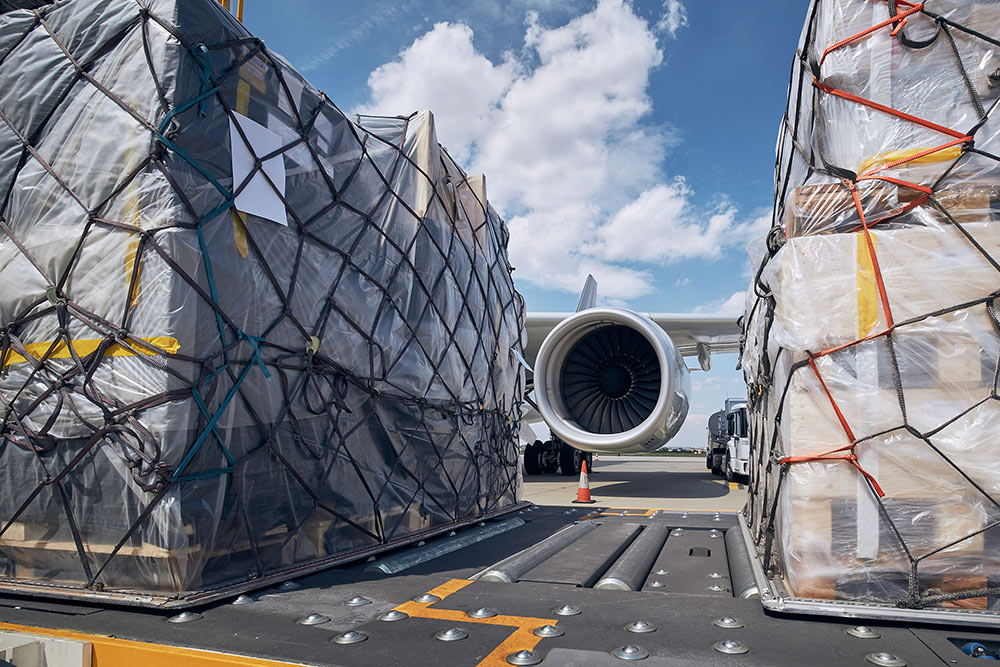The Ultimate Guide to Air Freight Shipping

Shipping freight by air is considered to be one of the most efficient and reliable ways to get your goods to where they need to be. It’s also often the most popular shipping solution when needing to send urgent deliveries or time sensitive cargo due to its fast transport times.
At Jenkar, we have over 40 years of experience in the air freight industry, so you could pretty much say we’re experts in the subject. We’ve taken all of our knowledge and written this handy guide to cover everything you need to know about air freight shipping, including the benefits, how to calculate costs and when you should consider air freight as your main shipping method.
What is air freight shipping?
Air freight shipping is the process of importing and exporting goods via an air carrier which can either be a passenger or commercial flight. Commercial cargo is a separate service to passenger airline cargo, as this is when an entire plane is dedicated to holding cargo which can range from large pallets, vehicles and machinery.
What can be shipped by air?
There are many goods that can be transported by air, however the most common items tend to include:
- Produce and perishable food items ie. seafood, fruit, vegetables
- Plants and flowers
- Pharmaceuticals
- Vehicles
- Machinery and equipment including spare parts
What can’t be shipped by air?
Naturally, there are regulations for what can’t be taken onto an airplane and these same regulations apply to air cargo. Prohibited items include hazardous and flammable items and anything considered to be dangerous, such as batteries, magnets or corrosive liquids. The list of prohibited items can differ between airlines however so it’s always worth checking whether your cargo falls under these restrictions.
The benefits of air freight shipping
There are a lot of benefits to shipping cargo by air, making it a popular freight forwarding solution. The biggest benefit to air freight is of course the speed of which a delivery can be made, sometimes being as quick as the same day. This mode of transport offers much faster shipping times than sea freight or road freight options due to the increase in departures and decrease in delays, also making it a more reliable solution.
If you’ve ever flown on a passenger flight, you’ll know that airports have strict security measures, which also extends to cargo. Due to tightly controlled air measures in place, this reduces the chances of your cargo being stolen or damaged.
There are some areas where costs can be reduced when shipping by air. This includes lower insurance costs as due to short transportation times, the insurance premium is lower. Costs can also be reduced surrounding packaging, as less heavy packing is required for air cargo, as well as there being less of a need for warehousing and storage thanks to fast cargo clearance and inspection.
How to calculate the cost of air freight
There are different methods of calculating the cost of air freight and this can differ between airlines and providers. The most common methods of calculating the cost however is determined on either volumetric or actual weight, whichever one is more.
To calculate volumetric weight, the length x width x height of the cargo is determined (in cm), giving the volume of the shipment. The volume is then divided by 6,000 to reveal the volumetric weight. If this is higher than the actual weight of the cargo, then this is what will be used to determine the cost of the delivery.
It is always best to contact a freight forwarder directly for a quote as they can work this out for you, rather than trying to estimate it yourself. Get in touch with a member of our team today who can help you to start building an air freight quote.
How to package an air freight shipment
No matter what the contents of your cargo are, all shippers should pay attention to how they package their shipment to ensure that nothing goes wrong, such as damages to or rejection of your cargo. First you should check that your cargo is the right size and doesn’t exceed the maximum air freight dimensions, which is 2.44 x 3.15m, nor should it exceed 1000kg.
We recommend using strong, high quality boxes for your shipment, particularly double-walled ones as these will offer better protection of your goods. Then ensure that your box is tightly sealed with high-quality packing tape.
Once your goods are packed up and ready for shipment, the final step is to make sure that you have all of the correct documentation and labels required. This should include a label indicating the contents, along with a commercial invoice, certificate of origin and an airway bill.
When should I use air freight shipping?
Given the fast, efficient and reliable benefits of air freight shipping, this transportation method should be used when you have a time sensitive shipment or when you’re shipping perishable goods. Air freight can also be the best method for shipping high-value or sentimental items or sensitive documents due to the high levels of security and controlled measures in place at airports.
There’s a lot to consider when preparing freight by air and we understand that this can be overwhelming and confusing at times. By choosing Jenkar as your freight forwarding partner however, you’ll rest assured that you’re in good hands as we’re here to help you navigate the complexities of the air freight industry.
With years of knowledge and experience, backed by our IATA accreditation, you can count on us to deliver your cargo to destinations worldwide swiftly and reliably. To discuss your cargo requirements and start building a freight solution tailored to your business, get in touch with our team today.
